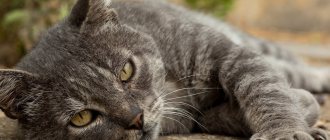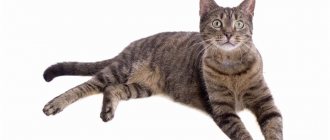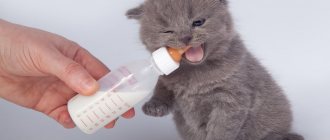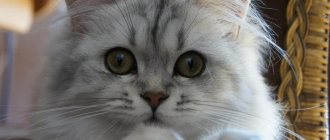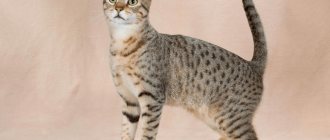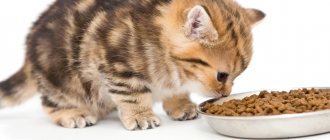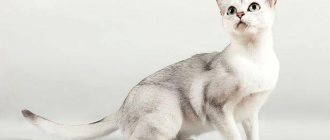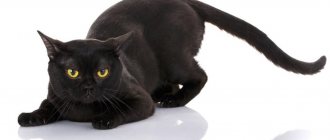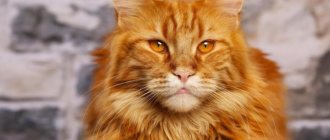The Bengal cat is a special and even unique animal. It was bred artificially as a result of crossing a domestic cat with a leopard and wild Bengal. The cat received from its ancestors a love of hunting and meat.
Unlike other breeds, Bengals are quite heavy - on average, an adult weighs about 8 kg. Despite the fact that they look “impressive”, they have a very sensitive digestive system. Therefore, they must be maintained according to certain rules. Having decided to buy such an exotic pet, its future owner should learn in advance about how to care for and what to feed a Bengal cat.
Basic nutritional features
In the wild, Bengal cats feed mainly on rodents and marsupials. These “products” can be replaced at home with different types of meat. For this breed, it is important that at least 70% of the total portion is meat.
The raw product is more beneficial for the animal. Since the likelihood of becoming infected with parasites from eating raw meat every day is very high, it is important to first freeze the meat in the freezer for at least 5 days.
Food for animals should be as fresh as possible. If the portion for your pet turns out to be too large and not finished, it should be thrown away and not left “for later.” All dishes should be neither hot nor cold. It is necessary that the food is at room temperature. Before giving meat from the freezer to the cat, it is recommended to pour boiling water over it and cut into small pieces.
The pet must know its place for feeding, as well as meal times. It is not allowed to give any snacks in response to an animal's begging.
Bengal cats can eat both natural products and ready-made premium commercial diets. It is not recommended to combine dry food with canned food or raw meat.
Choosing and caring for a kitten
If you just choose a pet, the choice is made on the baby you like best. The main thing is that he is healthy. This is evidenced by clean eyes, good appetite, shiny coat, and absence of swelling near the anus. When choosing a show-class pet, there are more requirements. The baby must meet the standard. This applies to color, exterior and character.
Three types of color are considered classic:
- rosetted (roset) – spots have a light base with a dark edging;
- marbled – dark patterns on a light background;
- spotted color (spotted) with evenly colored spots on the pet’s fur.
There are also more rare colors: lynx, mink, sepia. Until recently, Bengals were dominated by warm coat tones. Today the blue color is recognized, and snow Bengal cats have appeared. Moreover, the color of kittens does not appear immediately. Only in sexually mature animals does it become as bright as possible. The new owner can only guess what color a 4-month-old baby will have. Therefore, it is important to buy kittens only from reputable breeders.
Starter kit for rehoming a Bengal kitten
It will be different in each nursery. As a rule, it includes:
- contract of sale;
- veterinary passport with vaccination records;
- pedigree or metric indicating registration in the club;
- food that the baby is accustomed to;
- toilet filler;
- recommendations for feeding a kitten.
Other recommendations
When a kitten is weaned from its mother's breast, it is especially necessary to carefully monitor its nutrition. Typically, Bengals from three years old are fed five times a day in small portions. Its size, sexual function, activity and health will depend on a balanced and healthy diet (see size and weight of a Bengal cat).
But you shouldn’t think that if the kitten has grown up healthy and beautiful, then you can give up on its nutrition. His further appearance and well-being depend on this.
The history of the appearance of the leopard breed
American biologist-geneticist Jean Sugden, and after her marriage she was also Jean Mill, began to get involved in cat breeding during her student years.
In 1961, she bought a female wild kitten, Felis Bengalensis, at a market in Bangkok and brought her home to the United States. From her grew, although domesticated, but with the character of a wild predator, a leopard cat named Malaysia. After mating with a domestic black cat in 1963, the female gave birth to a hybrid spotted girl. But, alas, there was no further development of the offspring from this hybrid: the animal died of pneumonia.
After 15 years, Jean Mill was able to return to the topic of creating a domestic leopard breed - the cat of her dreams. For breeding she used F1 hybrid females and a wild Asian leopard cat with a bright, golden-orange tone.
In 1991, the Bengal breed took part in the TICA championship and won recognition among felinologists.
Diet
As a rule, representatives of the breed are not prone to excess weight. When creating a diet, you should also not forget about the anatomically shortened intestines, which means rapid digestion of food. The optimal number of meals is calculated according to the age of the pet:
- up to 1 month – upon request;
- 1-2 months – 5-6 times a day;
- 2-3 months – 4-5 times;
- 4-5 months – 3-4 times a day;
- from 6 months and adults – 2 times a day.
A few words about care
Most new owners are constantly worried about what to feed their Bengal kitten. The peculiarities of caring for a purebred pet also raise many questions, although in fact, Bengals do not cause almost any trouble in caring for them.
The kids are playful, quickly trainable and understand all the commands of their owners. If you teach them to follow certain rules from an early age, you will get an obedient adult cat with a balanced character.
Bengals love cleanliness, so their litter box should always be thoroughly cleaned. It is best to choose wood litter, since cats of this breed love to bury their excrement and cannot stand foreign odors.
From their wild ancestors they inherited a love of water and walks, so be prepared to purchase a harness and give your pet good exercise at least once a week. Kittens love to splash and splash water, they even drink it after carefully pushing away the non-existent dirt with their paws. In this regard, children should change the drinking water in the bowl at least twice a day.
Mini leopards are great at grinding their claws off on their own, but their ears and eyes need to be kept clean. It is enough to wipe them daily with a soft cloth.
As you can see, cats of this breed do not cause much trouble, but I would like to talk in more detail about their feeding. What to feed a Bengal kitten? The question is not an idle one, because the pet’s mood and health depend on the diet. Let's look at this topic.
How to buy a Bengal kitten
Breeders do photo sessions for small pets and their parents. And then colorful photographs with information about the sale of purebred kittens are posted on:
- websites of official nurseries;
- forums of breeders and felinologists on social networks;
- cat shows;
- ad platforms.
Felinologists sell show-class spotted kittens at a high price. Their price will not be lower than the cost of the kitten. After all, the financial costs of caring for, maintaining and breeding Bengals are high, so five kopecks even for a pet-class kitten is not a serious approach for the future owner of a leopard cat.
But surrogate kittens without documents are sold at city bird markets, on Avito and Yula. Therefore, after purchasing such a spotted baby, you should not ask yourself the question: “is this really a Bengal cub?”
Look, even by the quality of the photographs of the cub on the ad, you can already compare the price and class of the breed.
What to feed a Bengal kitten
Like other cat breeds, Bengal cat babies must be fed exclusively on mother's milk for the first 4-5 weeks of their lives. At this stage, it is quite enough to obtain the necessary useful elements. For the mother cat herself during this period, special ready-made premium or holistic foods are more suitable.
From the first month of life, little “predator leopards” can already try some natural products. Experienced veterinarians recommend taking thawed and chopped meat, high-quality homemade minced meat or meat porridge cooked in water as the first complementary food.
Over time, you can offer kittens larger pieces of meat. As an option, you can use delicate ready-made pates and mousses that are made for animals of this age.
The second optimal product for complementary feeding is cottage cheese. Since it can be difficult for a baby to swallow, it is worth diluting it with low-fat milk or homemade yogurt. The animal should be accustomed to vegetables last.
Bengal cats must eat kitten food until they are 8-12 months old. After a year, they can switch to adult food.
Photos of Bengal cats
The appearance of domestic Bengals amazes and surprises purring lovers with their short shiny fur. The smooth coat has a variety of spotted colors.
Bengal cats differ from each other in their unique, individual patterns of spots, rosettes, and stripes.
Representatives of this elegant, graceful breed have:
- slender, muscular, elongated body;
- soft, round paws,
- slightly elongated head with medium-sized ears.
- the tip of the thick, short tail is painted black.
Males of the Bengal breed grow into large cats weighing up to 10 kilograms, while females weigh a couple of kg less. And the skeleton of cats is more powerful, larger than that of female cats.
Photographs by professional photographers and photographs of cat owners best convey the appearance of their leopard pets.
Useful stuff:
the ability to take subject photography and process photos can be useful not only to animal owners, but also to novice photographers. To try your hand at learning how to use Photoshop correctly with free lessons, click on the arrow>>>
List of contraindicated products
When developing a diet for your kitten, do not forget that some foods are simply contraindicated for him. These primarily include milk - it causes stomach upset. But yogurts, kefir and yogurt will become an important source of protein.
You should immediately give up potatoes and eggplants - Bengals tolerate them very poorly.
Also, don't get carried away with fish. In the wild, Bengal cats eat it extremely rarely, and therefore are not very adapted to digest it. In addition, frequent consumption of fish causes serious problems with the urinary system.
Natural food for an adult Bengal cat
Some owners prefer natural feeding. When preparing daily dishes for your Bengal, it is important to consider that the following products should be present in his diet:
- Meat . The optimal daily volume of meat is 60-65% of the total volume. A lack of proteins and other substances necessary for the normal development and growth of a pet occurs when the meat volume decreases to 40-45%. Pre-frozen and then scalded pieces of raw meat are ideal for Bengals - for example, chicken, rabbit, veal, chicken necks.
- Offal . With great pleasure, Bengal cats eat raw hearts, gizzards, tripe, kidneys and lungs. They, like meat, must first be frozen in the freezer and then scalded in boiling water.
- Fish . Allowed once a week. It is recommended to give preference to sea fish, previously boiled and deboned.
- Dairy and fermented milk products . Adult Bengals are happy to try cream with a fat content of up to 20%, as well as low-fat yoghurts, fermented baked milk, kefir and cottage cheese.
- Eggs . Bengals refuse boiled eggs. Therefore, the best option for them would be raw quail egg yolks. They can be given no more often than 1-2 times every 7 days.
- Vegetables . The share of vegetables in the total serving should be no more than 20%. Carrots, zucchini, beets, and sweet peppers are allowed to be given both raw and boiled.
- Cereals . They will be an excellent addition to the diet, but their norm should be limited to 5-7% of the total serving per day.
- Greenery. Added to dishes (porridge, minced meat) as an additional source of vitamins: spinach, lettuce, sprouted grass.
Natural feeding of a Bengal cat should be supplemented by periodic intake of mineral and vitamin complexes, since it is impossible to fully compensate for the lack of beneficial minerals from food.
Breed characteristics
How difficult is it to care for the breed? | There are no particular difficulties. You need to care for your Bengal just like a regular house cat. |
Do Bengals need special food? | The diet of the breed is no different from the menu of other domestic cats. |
What size do they reach? | This is a fairly large breed. She has pronounced sexual dimorphism. Males weigh 6–9 kg, females 3–5 kg. |
Besides color, does the breed have any similarities to its wild ancestors? | Cats have hind legs that are longer than their front legs, and this gives the animal a special gracefulness to its movements. They also have a silky coat, and they have a special coat structure, as well as the “ugly duckling” stage inherited from their ancestors - phasing. |
What is phasing in Bengal cats? | Phasing is a protective gray fluff that covers the bright color. It appears at 1.5 months. At this age, in nature, kittens leave their mother's den and need camouflage. Babies of all wild cats are susceptible to phasing. |
At what age do Bengals acquire the characteristic color of the breed? | By 3–4 months, phasing usually disappears. But the color is finally formed before the age of 8. At this age, cats become sexually mature. |
Why are kittens of this breed so expensive? | The breed is not very common and difficult to breed. And breeding work requires significant financial investments. All this affects the price of kittens. However, in each litter there are more and less valuable kittens. The most expensive ones are with a phenotype as close as possible to the standard. |
Are Bengals hyperactive cats? Can they live in an apartment and not create chaos around them? | Pets can be mischievous. For them, running along window sills and jumping on the sofa is just a game. Even as they grow up, they remain kittens in temperament. But they have high intelligence. They are easy to train and quickly understand what they are allowed to do and what they are not allowed to do. |
Do Bengals leave marks in the house? | Unfortunately, animals of two sexes mark their territory. And during the period of rutting and estrus, the night calls of the sexual partner can also be heard far away. The problem can be solved by sterilizing pets. |
Is it true that Bengal cats have a special relationship with water? | Bengals love water. They enjoy playing with a stream of water, splashing water from basins left unattended. And before drinking, they instinctively rake out the non-existent algae in the container with their paw. |
They say Bengal cats don't shed. So are they suitable for allergy sufferers? | Representatives of the breed have short, silky hair. She doesn't shed much. But this does not mean that pets do not cause allergies. Moreover, for allergy sufferers it is not so much the fur that is dangerous, but the saliva and other secretions of animals. |
How does a Bengal cat behave in the house? | The cat chooses one “favorite” in the family and accompanies him everywhere. But she also loves to play with other people she knows well. |
Attitude towards children and other family members | Bengals are very sociable. They play with both children and adults. |
Attitude towards other animals, dogs | They get along well with animals. Preferred playmates are small breed dogs. They say that a Bengal is a puppy in a cat's body. |
Do Bengals need walking? | If possible, pets should be taken for a walk. They quickly get used to the harness and walk with pleasure. |
What gender should you choose a kitten as a pet? | Males are more massive than females, but females are more graceful. As for character, everything is individual. Choose the kitten that you like best. |
How long do Bengal cats live? | Average life expectancy is 12–15 years. There are also centenarians reaching their 20th anniversary. |
Advantages of the breed
- Has an extravagant appearance. This is a real indoor leopard with a good disposition.
- This is a strong, agile animal with a strong hunting instinct.
- Bengal is an intellectual. He grasps everything on the fly and quickly learns to understand his owner.
- His ability to train and remember commands is unique. This is a talented student who can be taught to perform various tricks.
- Friendliness and sociability are in his blood. Despite their physical strength, all Bengals are not aggressive. They don't bite or scratch.
- One of the cleanest animals is the Bengal cat. The description of the breed says that they have a silky coat. They take care of her themselves. Pets are bathed very rarely; as a rule, this is done before exhibitions.
- An interesting voice, not like the usual meow. The range of sounds is very wide - from simple rumbling to purring and clicking of the tongue. Owners note that these sounds resemble barking.
- Larger than most breeds. The average weight reaches 5–8 kg.
- These cats are excellent jumpers. Thanks to their elongated hind legs, they make long and high jumps of amazing strength.
Disadvantages of the breed
- The breed is considered one of the most expensive. A cat named Kato holds the Guinness Book record for being the most expensive. In 1998, a London resident bought it for 41 thousand dollars.
- The high price has led to the emergence of unscrupulous breeders who want to make money on the popularity of the breed. More and more kittens are being born with genetic abnormalities.
- Pets need physical activity. You need to walk with them at least once a week, and preferably more often.
- Socialization needs to be given significant attention. It is important to teach babies to use their hands, otherwise they will grow up wild.
- The passion for marking territory was passed on to domestic animals from their wild ancestors. Only castrated animals do not have this extremely unpleasant habit.
- The high activity and playfulness of the breed will not appeal to pedantic people who value order. Mini leopards love to run around everywhere, turning over flower pots or stacks of neatly folded things.
- They are extremely curious, interested in the contents of cabinets and chests of drawers with slightly open doors.
Feeding newborns and very young cats
Newborn kittens are almost never sold, because they are very difficult to care for and feed. This burden falls entirely on the kitten's mother. She will do the best job feeding a young Bengal.
The cat feeds very small Bengals
If there is no cat, but the kitten still comes to you, then you will have to watch it especially closely. You need to feed a kitten that is not even a month old with milk. Special mixtures and cat milk substitutes work well. I can recommend “KITTY-MILK” from Beaphar.
KITTY-MILK
The same powder can be used for additional feeding of kittens that feed on mother's milk. Many experts consider this substitute to be one of the best. Feed should be strictly according to the instructions.
Kittens from 1 to 4 days should be given 30 ml. mixtures per day per 100 grams of their weight.
When your pets are 5-13 days old, you can give them 38 ml. mixture per 100 grams of their weight, thereby gradually increasing the dose of nutrients.
What to feed a Bengal kitten who is two months old
Once they reach two months, kittens are fed more than just milk. An excellent option would be to start feeding him what is natural for him in nature - meat. But it needs to be prepared in a certain way, so as not to harm the kitten. At first, it is better to boil the meat, then cut it into very small pieces.
But in nature, no one cooks meat for cats, so you can give raw meat, in which case it will need to be frozen for a long time. At first, it’s better to play it safe and leave it in the refrigerator for several days or weeks. Then a thin layer is removed from the meat using a knife. The resulting shavings are doused with boiling water and given to the kitten.
Bengal at 2 months
Another good option would be porridge with meat, for example, rice. It should be given with plenty of water or milk. The finished product should resemble a thick substance.
How to feed in a new home
Three to four months is the right age to move. The new owner will have to take care of the proper nutrition of the young Bengal. For the first two weeks, it is recommended to feed your pet exactly the same food that he received in the nursery. The amount of meat in the diet should be increased to 60%. Fermented milk products are limited to no more than 20%.
The remaining 20% comes from porridge, which is already quite thick, and boiled vegetables. Begin to introduce a small amount of raw vegetables: carrots, asparagus, cauliflower. At 4 months the kitten is fed four times a day, at 5 months - three times. By the year the number of feedings is reduced to two, and the share of meat is increased to 80%.
How to organize food for a young Bengal:
| Age | Events | Feedings per day |
| 3 weeks | First feeding, paste mixture | |
| 1.5 months | Shredded or moistened dry food | 7-8 |
| 1.5-2 months | The basis of the diet is mother’s milk, continuation of complementary feeding, number of feedings | 6 |
| 3 months | You can give dry food in small granules. Dairy nutrition is gradually reduced to 20% of the total diet | 5 |
| 4 months | The amount of meat is adjusted to 60%, the rest is light porridge. | 4 |
| 5 months | Accustoming to raw meat and dairy products. Dry food is given without grinding or soaking | 3 |
| 6 – 12 months | Transition to an adult diet | 2 |
“Bengals have a bright character; when it comes to food, they can be real picky. The owner will need to be patient and attentive to regulate the pet’s diet.”
Ready-made formulations
Even before a purebred pet appears in the house, you need to decide whether its diet will consist of natural products or prepared food. Experienced breeders do not recommend mixing these two types of nutrition.
Characteristics of suitable ready-mixes:
- high quality;
- balanced composition;
- appropriate for the pet's age.
Premium ready-made food is expensive, but the cost of purchasing it is more than justified. Such mixtures contain all the necessary elements and vitamins necessary for the health of the kitten.
“At eight to nine months, Bengals’ intestines remain very fussy. It is not advisable to switch to another brand of food or type of nutrition at this time.”
When choosing a composition, in addition to the age of the kitten, you should take into account all its features:
- presence or absence of sterilization;
- the kitten's attitude towards the composition;
- changes in his bowel movements;
- allergies.
Some breeders give Bengal kittens food intended for cats during pregnancy or lactation. Super premium formulations received good reviews:
- Royal Canin Mother & Babycat is a dry food for pregnant mothers and kittens up to four months, rich in proteins, probiotics, vitamins, easily digestible, and quickly becomes mushy in water.
- Royal Canin Kitten - a composition for kittens that have reached four months, supplemented with natural fiber, which improves intestinal function, and contains a sufficient amount of calories for an active pet.
- Sanabelle Kitten - suitable for cats and older kittens under one year of age, rich in amino acids, well balanced, stimulates the immune system.
- Pro Plan Nutris Vour Junior - “wet food for kittens and nursing cats, rich in omega acids, phosphorus, calcium, suitable for first feeding.
- Iams Kitten & Junior Chicken in Sause - canned chicken, which can be offered from those weeks, is rich in microelements, vitamins, fiber, healthy fats, suitable for mixing with other types of food.
Some Bengals are allergic to Royal Canin. If, after using a new food, the kitten begins to itch and lose hair, and diarrhea is observed, most likely this is an allergic reaction. It can occur for any composition, even the most expensive. But cheap food, which is widely advertised, is an even greater evil. Poor nutrition is not only useless, it does a lot of harm and contributes to the development of dangerous diseases.
There are formulations for neutered individuals; they are designed to meet the needs of sterilized kittens and protect against excess weight. If your stool becomes loose after using a new food, it is best to look for a different brand. It is very desirable that the little Bengal likes the taste. This will speed up the adaptation to the new food and improve appetite.
“You don’t have to buy a large package of ready-made food right away. To begin with, you can take a small portioned bag.”
Natural nutrition
Some breeders are confident that natural food is preferable for Bengals, since it better suits the digestive characteristics of cats of this breed. In order for the diet to be balanced, it is necessary to introduce additional vitamin and mineral complexes. Specific recommendations can be obtained from your veterinarian. He will help you choose medications and tell you when and how to give them.
“If for some reason your Bengal kitten must be mixed fed, two separate bowls should be used: one for natural foods and one for pellets or pates.”
Bengal kittens do not tolerate changes in diet well. A change to a different brand of food or a complete change in the type of diet is carried out only if there are sufficiently compelling reasons. The transition should be gradual. You need to carefully monitor the kitten’s condition during this period and try to reduce stress for the pet.
The basis of a natural diet is meat. It should be:
- low-fat;
- fresh;
- without veins, skin, or other inclusions.
Beef is considered the most suitable. Chicken, turkey, rabbit, and veal are also suitable. The skin and fat must be carefully removed. You can give raw or boiled meat. In the first case, the product is frozen for several days in the freezer. Boiled meat is safer, but it loses some of its beneficial properties.
In addition to fillets, you can offer kittens some offal. Chicken gizzards or hearts will do; they need to be finely chopped. Liver is given very rarely; some breeders do not consider it suitable for this breed. It is not recommended to use pork or lamb for feeding.
Bengals have a complicated relationship with fish. For cats it is considered dangerous in any form. Kitties are sometimes given sea fish fillets, boiled or raw. The product must be fresh. Food is served at a moderate temperature: not too cold, not too hot.
Fresh chicken necks, without skin but with cartilage, are considered suitable for kittens. They need to be ground in a meat grinder. Bengals should not be given any other bones. Ground necks contain many beneficial substances for the growing body, especially in the period from four to nine months. But they don’t have enough calories, so you can’t make them the basis of your diet; you need to supplement it with meat.
Kittens should not be given:
- pork;
- beef;
- bones;
- cartilage;
- ready minced meat;
- potatoes in any form;
- broccoli, onion, garlic;
- legumes (peas, beans);
- stale (stale, weathered) meat;
- skin.
You cannot feed Bengal kittens food from the human table. This diet is not balanced. Pieces of skin, bones, and beak claws are unacceptable; the pet may choke.
Foods that are not suitable for Bengal kittens:
| Type of unwanted product | Why is it dangerous? |
| Fish and bird bones | May cause intestinal blockage, damage the stomach, esophagus |
| Lamb, pork, poultry | Without heat treatment leads to infection with worms and infectious diseases |
| Spicy, fatty, smoked, canned foods, salt, spices | Disturbs metabolism, causes intestinal upset, and leads to chronic diseases |
| Confectionery | Impair metabolism, reduce the body's resistance to diseases |
| Chocolate | Contains theobromine, which may cause poisoning |
| Potato | Excess starch makes intestinal function difficult; the product does not contain substances beneficial to the kitten |
| Legumes | Not digestible, causes bloating |
A couple of times a week you can offer a lightly beaten egg: one chicken or two quail. Not all Bengal cats like raw eggs. Some people only like the yolk. Cottage cheese in moderate quantities is very useful for growing kittens. 20-40% of a kitten's diet should be non-meat products. Vegetables are suitable, first they are introduced boiled, then they begin to be given fresh. Vegetables are chopped and mixed with meat.
Porridges are low-calorie carbohydrates that kittens have difficulty digesting. Bengals should be given some boiled unsalted rice. Other porridges are also suitable; there should be a small amount of them compared to the amount of meat. Sometimes you can offer your pet thick pureed soups made from meat with vegetables, without salt.
The best ready-made diets
Having analyzed the cat food market, veterinary specialists and breeders have identified the most optimal production rations that best satisfy the needs and characteristics of purebred representatives.
- WildCat Etosha . Dry natural food from a German manufacturer. Belongs to the category of holistic products, that is, the most balanced products. It is distinguished by its high protein content (approximately 46%) and the presence of flaxseeds.
- Orijen Six Fish Cat . Canadian food based on fish products. Rich in proteins. Also includes vegetables, fruits, grain products.
- CARNILOVE Salmon for Adult Cats . This food is made by a Czech manufacturer. Created specifically for those breeds of cats that are as close as possible to their predatory ancestors. 36% consists of crude protein.
- Royal Canin Bengal Adult . Premium product from a French company. Ideal for Bengals over one year of age. 40% consists of proteins.
- Eukanuba Adult with Chicken . Quality product from the Netherlands. It is high in protein and also includes fatty acids and probiotics.
Ready-made foods are also great for small kittens, for example, from Brit Care, Fitmin For Life, Leonardo, Summit.
If the owner has opted for finished products, it is important to ensure that the pet has constant access to fresh water. In addition, the owner should not feed the Bengal with vitamins, since food from the holistic and super-premium categories contains the daily requirement of all minerals. Otherwise, hypervitaminosis will occur, which causes discomfort and discomfort in the pet.
Water
At any age, regardless of the type of Bengal diet, drinking water should always be freely available in the bowl. Do not give your cat water from the tap. It contains chlorine and other chemical compounds that are unsafe for animals.
Veterinarians recommend using pre-settled, filtered soft drinking water for kittens to drink. You can also give your kitten bottled artesian water without gas.
Always wash bowls before adding water. The water is changed once or twice every knock. Make sure that there are no food particles, insects, or other third-party particles in it.
What you should absolutely not give
What to give your pet - dry food or natural food - is up to you. To prevent your animal from having intestinal problems, take note of the list of treats that you should never feed it with. The following prohibited products are identified:
- fatty meat (duck, pork, turkey). Firstly, it will be difficult for the cat to absorb. Secondly, a cat can become infected with helminths or dangerous infectious diseases from poultry;
- smoked and spicy dishes;
- sweets. This is generally taboo for the Bengal cat. From them, her teeth and fur can deteriorate, and her metabolism is noticeably disrupted;
- peas, beans and soybeans. If your pet consumes these products, bloating will inevitably occur;
- salty or peppery food. No spices, otherwise you will have to treat the cat for serious stomach problems.
Similar article: Characteristics of a samurai cat of the Japanese Bobtail breed
There are times when a cat suddenly gets sick. No matter what the cause was, treating your pet with human vitamins and medications is strictly prohibited. Otherwise, the animal’s kidneys may fail or the body may even become poisoned. Follow the key recommendations regarding feeding your four-legged friend, and he will delight you with his good health and excellent appearance.
Character
The intelligence of Bengal cats is a mixture of incredible intelligence and instincts. The animals have a pronounced intelligence, cunning and cunning, which were probably passed on to them from their predatory ancestors. Bengal cats have well-developed front legs. They use them not only for walking or playing, like regular cats. Bengals try to pick up an object in their paws and even move it from one place to another.
They are incredibly playful and curious. They always try to get into places where they don’t need to. They can stare at a running washing machine for a long time, as well as out the window, watching passers-by. But for all their curiosity, Bengal cats are also smart. Therefore, they can climb anywhere, but they will never stick their nose where they may be in danger. You should not leave Bengal cats alone at home for a long time. Because they are very active. Their playfulness does not fade even with age.
